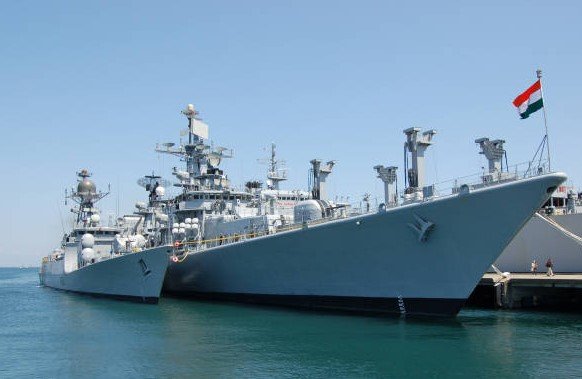India’s defense shipbuilding industry is booming amid growing concerns over China’s expanding naval presence in the Indo-Pacific region. As of September 2025, this tension has triggered massive government orders worth up to Rs 1.75 lakh crore, boosting stocks like Mazagon Dock, Swan Defence, and Cochin Shipyard.
Rising Geopolitical Tensions Fuel Demand
China’s rapid naval buildup has raised alarms in India, prompting a strong response to strengthen maritime defenses. With Beijing adding advanced warships and submarines at a fast pace, New Delhi sees an urgent need to modernize its fleet to protect vital sea lanes and coastal assets.
This shift comes as India aims to counter potential threats in the Indian Ocean. Recent reports highlight China’s fleet surpassing 370 ships, far outnumbering India’s current 150 active vessels. In response, the Indian Navy plans to add over 170 ships by 2035, focusing on self-reliance through local production.
Experts point to incidents like the 2020 border clashes and ongoing South China Sea disputes as key drivers. These events have pushed India to accelerate naval projects, creating a ripple effect on the stock market.

The push aligns with global trends, where nations like the US and Australia are also ramping up defenses against similar threats. For India, this means more contracts for domestic firms, turning geopolitical risks into economic opportunities.
Government Push for Self-Reliance
The “Make in India” campaign plays a central role in this growth story. Launched to promote local manufacturing, it has funneled billions into defense sectors, including shipbuilding.
In the 2025 budget, the government allocated Rs 25,000 crore for a Maritime Development Fund. This fund targets shipping, ports, and shipyards, aiming to attract Rs 1.5 lakh crore in investments by 2030.
Recent approvals include a Rs 69,700 crore shipbuilding package, granting infrastructure status to large vessels. This move eases financing and speeds up projects, directly benefiting public and private players.
| Key Government Initiatives | Details | Impact on Sector |
|---|---|---|
| Maritime Development Fund | Rs 25,000 crore allocation | Boosts financing for new builds |
| Make in India Push | Focus on indigenous tech | Increases local orders by 20% |
| Rs 80,000 Crore Tender | For advanced warships | Potential contracts for major firms |
| Infrastructure Status | For large ships | Lowers costs and attracts investors |
These steps address India’s goal to expand shipbuilding capacity from 0.072 million gross tons to 0.33 million by 2030. With global leaders like China and South Korea booked solid, India spots a chance to grab more international deals.
Spotlight on Top Shipbuilding Stocks
Three companies stand out as prime beneficiaries of this boom: Mazagon Dock, Swan Defence, and Cochin Shipyard. Their stocks have surged, reflecting investor confidence in upcoming orders.
Mazagon Dock, a public sector giant, specializes in warships and submarines. It recently signed deals for fast patrol vessels and is eyeing a Rs 80,000 crore tender for landing platform docks.
Swan Defence, a rising private player, focuses on innovative marine tech and partnerships. It benefits from strategic tie-ups, positioning it for green vessel contracts amid global sustainability trends.
Cochin Shipyard excels in building advanced frigates and aircraft carriers. It laid the keel for new anti-submarine crafts this year and plans expansions in Tamil Nadu.
- Stock Performance Highlights: Mazagon Dock shares jumped 68% in 2025; Cochin Shipyard hit new highs on robust orders; Swan Defence gains from export potential.
- Growth Drivers: Strong order books, government support, and international MoUs.
These firms are set to capitalize on a projected sector growth to Rs 70,478 crore by 2033. Analysts predict continued rallies as more tenders roll out.
Market Projections and Economic Impact
The defense shipbuilding market in India could generate 10 million compensated gross tonnes of work by 2030. This surge stems from the need to patrol 7,500 kilometers of coastline and secure energy imports.
Projections show India’s global market share rising from under 1% to top 10 by 2030. Events like the commissioning of stealth frigates Udaygiri and Himgiri in August 2025 underscore this momentum.
Economically, the sector promises job creation and tech advancements. It ties into broader goals like Maritime India Vision 2047, aiming for 11.31 million gross tons capacity.
However, challenges like supply chain issues and skill gaps remain. Balancing defense needs with commercial builds will be key to sustained growth.
Challenges and Future Outlook
While opportunities abound, the sector faces hurdles. Private yards hold a small market share, dominated by public undertakings. Expanding capacity requires heavy investments and skilled labor.
Global competition adds pressure, but India’s cost advantages help. Recent MoUs with Germany for submarine tech show promise for collaborations.
Looking ahead, the Indian Navy’s Rs 2.4 trillion plan for new warships and submarines signals long-term gains. Stocks in this space may see volatility, but fundamentals look strong.
As this story unfolds, share your thoughts in the comments below. What do you think about India’s naval strategy? Spread the word by sharing this article with fellow investors.
